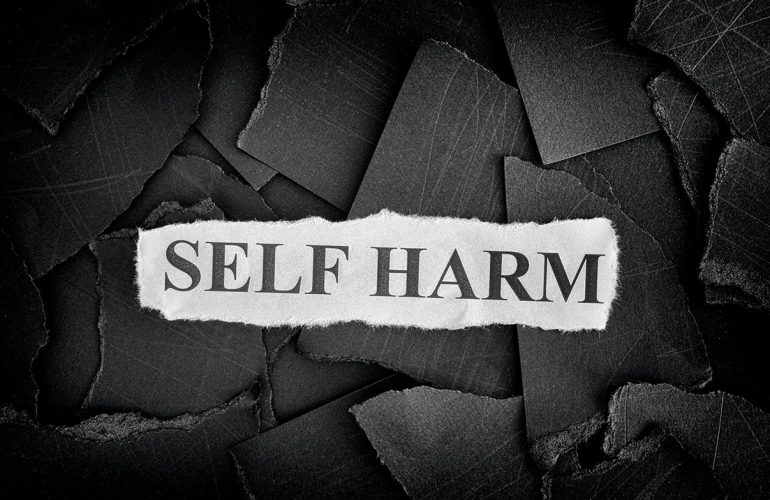Self-injury is the deliberate injury or alteration of one’s body tissues without the intent of suicide. Most times, these acts are performed to relieve distressing thoughts or emotions or sensations of unreality or numbness. According to the Mayo Clinic, self-injury is often performed impulsively, and is at times referred to as an impulse disorder. There are several other names for this condition found throughout the scientific and academic literature including self-harm, self-injurious behavior, self-mutilation, self-abuse, self-inflicted violence, and non-suicidal self-injury or parasuicide.
Harm to the Skin: Cutting
The type of self-harm that one engages in depends on many factors including personality, emotional or mental state, and history of psychiatric illness. Some individuals may begin by cutting themselves by lightly scratching the surface of their skin and then progressively get worse and cut deeper to draw blood. Others may brand themselves with items they can heat and apply to their skin.
Embedding
Other individuals have experimented with embedding objects, such as rings and metal objects under their skin. This is a controversial form of self-injury, because some people view it as a culturally accepted form of self-expression and not self-harm. Still others will burn themselves by using various objects and causing friction to the skin.
Dermatillomania: Skin Picking
Some people engage in a behavior known as skin picking which is also known as dermatillomania or excoriation disorder. This, too, is controversial because it may be less about self-harm and due more to obsessive compulsive behaviors. Interfering with wound healing may be another form of either self-harm or dermatillomania.
Extreme Body Piercing and Tattooing
Another form of self-harm that may or may not be considered an illness but rather a culturally acceptable form of self-expression is extreme piercing or tattooing, which has existed in one form or another throughout world history.
Self-Abuse and Poisoning
Other forms of self-injury include hair-pulling (trichtotillomania), bone-breaking, hitting and punching one’s self, and head-banging. Other individuals may try to harm themselves by consuming harmful chemicals, poisoning themselves, and overdosing on drugs and other substances.
Risk Factors for Developing Self-Injury
The age that these types of behaviors begin to occur is between the adolescent and teens years. It has been shown in research that various forms of emotional and mental illnesses may be associated with harming one’s self, especially depression, phobias, conduct disorders, impulsive disorders and substance abuse.
Some experts say that poor coping skills and emotionally invalidating environments may be associated with self-injury. Others point out that childhood abuse may be a risk, as well as troubled parental relationships, lack of support systems, and a family history of self-harm and suicide. In some cases, Autism, bereavement, poverty, and unemployment may be associated with self-injury.
Demographics and Statistics
Accurate statistics of people who engage in self-harmful behaviors are very difficult to obtain, because until an individual seeks treatment, they will be left out of the count. Rates of self-harm appear to be much higher among younger people, with an average age at onset being 12 and the earliest reported cases being among 5 and 7-year old children.
In some surveys, up to 10% of young people admit they intentionally hurt themselves in some way, including head-banging, scratching, and hitting one’s self. Around 1% to 4% of the American population engage in some form of superficial self-harm. Individuals diagnosed with intellectual and developmental disabilities have a much higher rate of self-harm, roughly around 15% to 20%.
Final Thoughts on Self-Injury
Self-injury is a serious emotional problem that appears to start earlier in life and then progressively worsens as the individual ages. While many causes and risk factors are associated with the behavior, it is still unclear if it is due to co-occurring illnesses like OCD, depression, or substance abuse. More research is greatly needed to determine, perhaps, if self-harm is genetic, learned, or in many cases, an act of self-expression.
(NOTE: Interested in learning more about Behavioral and Mental Health? Checkout my Behavioral and Mental Health CEUs on CEU Academy and try a FREE CEU today!)
More Behavioral and Mental Health Articles
- Psychology of Obesity: A Brief Introduction
- Does Munchausen Syndrome Exist?
- Lockdown, Drug Use and Suicide
- Caregiving, Diet and Depression
- Post Traumatic Stress Disorder (PTSD) In Later Life
- Post Traumatic Stress Disorder (PTSD) In Later Life
- De-Escalation in Senior Care
- Aging and Depression
- Mental Illness and Stigma
- Mental Illness and Aging
- Geriatric Suicide
- Crisis Intervention in Mental Health
- Behavior Management The Person Centered Way

